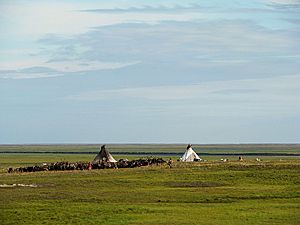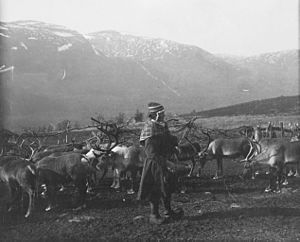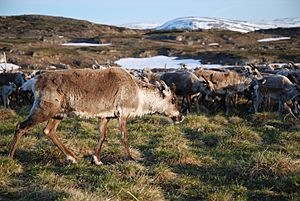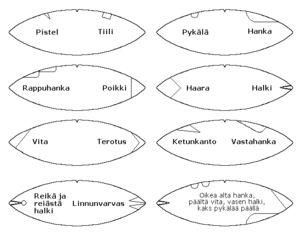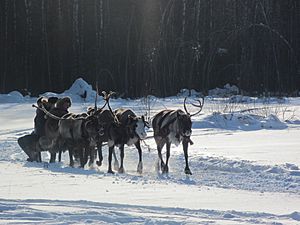Reindeer herding facts for kids
Reindeer herding is when people guide and care for reindeer in a specific area. Reindeer are special because they are the only semi-domesticated animals that naturally live in the North. People herd reindeer in nine countries: Norway, Finland, Sweden, Russia, Greenland, Alaska (part of the United States), Mongolia, China, and Canada. There's also a small group of reindeer in Scotland.
About 100,000 people around the Arctic Circle work as reindeer herders today. They often work together in groups like families, villages, or larger communities.
Contents
How Reindeer Became Domesticated
It's a bit of a mystery how reindeer first became domesticated. When the last Ice Age ended, people followed reindeer north. They used traps to hunt them. Some old rock art suggests that people might have started domesticating reindeer in the Sayan Mountains (between Russia and Mongolia) about 2,000 to 3,000 years ago.
Another idea is that the Tungus people (ancestors of today's Evenks and Evens) tamed reindeer on their own, east of Lake Baikal. This means reindeer herding might have started in different places at the same time. Reindeer herders themselves have their own stories about how this happened.
No matter how it started, taming reindeer changed life in the North. Reindeer sleds appeared later than dog sleds. But reindeer sleds made it possible to travel across the tundra and mountains. Reindeer became the best way to travel across the huge lands of Eurasia.
Sámi People and Reindeer

The Sámi people have a long history with reindeer. They lived and worked in groups called siiddat. Reindeer were used for travel, milk, and meat. A siida was an old Sámi community system. It was a working group where members shared resources and helped each other. A siida could include several families and their reindeer herds.
In the 1800s and 1900s, country borders divided the traditional Sámi reindeer herding areas. These borders were between Norway, Sweden, Finland, and Russia. This made it harder for Sámi people to continue their traditional ways of herding.
About 6,500 Sámi people herd reindeer in Scandinavia. In Norway and Sweden, reindeer herding involves large herds. Modern machines are used a lot. The main product from reindeer herding is meat. But skins, bones, and horns are also important. They are used to make clothes and handicrafts.
Norway
In Norway, reindeer graze on huge areas, about 146,000 square kilometers. This is 40% of mainland Norway. Only Sámi people who are part of certain families can herd reindeer in these main areas. However, in some southern parts of Norway, non-Sámi people can also herd reindeer.
About 2,936 reindeer herders care for around 240,000 reindeer. Most of these are in the Finnmark area. The Norwegian Reindeer Husbandry Administration manages reindeer herding.
The number of reindeer in Norway changes over time. For example, there were 242,000 reindeer in 1990, but 172,000 in 2000. Bad weather, more predators, and poor pastures can cause these changes.
Reindeer herders earn money from selling meat and other parts like skins and horns. They also get financial help from the government. A big part of their costs goes to running and fixing their machines.
Sweden
In Sweden, reindeer herding happens in many northern provinces. The herding area covers about 226,000 square kilometers. This is about 55% of Sweden.
About 2,500 people work in reindeer herding in Sweden. The right to herd reindeer belongs only to the Sámi people. To herd reindeer, a person must be a member of a Sámi reindeer herding village, called a Sameby. There are 51 such villages.
An exception is "concession villages" in the Torne Valley. In these villages, non-Sámi people can own reindeer. But a Sámi person must still do the actual herding. A non-Sámi owner can't have more than 30 reindeer.
Every reindeer must have an earmark. This is a special pattern of cuts in its ears. The earmark shows who owns the reindeer. All reindeer born in a year must be marked by October 31st.
The number of reindeer in Sweden changes, usually between 150,000 and 300,000. In 2007, there were about 220,000 reindeer. Each Sámi village has a maximum number of reindeer allowed. Herders count their reindeer each year.
Finland
In Finland, reindeer herding is done through "reindeer herding districts" called paliskunta. There are 56 such districts. They have clear borders and vary in size and number of reindeer. The total reindeer herding area in Finland is about 122,936 square kilometers. This is about 33% of the country.
Unlike Norway and Sweden, any European Union citizen can herd reindeer in Finland. However, they must be approved by a district and live in that district's area. Most of the 5,600 reindeer herders in Finland are Finnish.
The number of reindeer in Finland has grown over time. In the early 1900s, there were just over 100,000. By the 1970s and 1980s, it reached over 250,000. In 2004/2005, there were about 207,000 reindeer. The government sets a maximum number of reindeer for each district.
For most people in Finland, reindeer herding is a way to earn extra money, often alongside farming or forestry. But for the Sámi in Finland, it's very important for their economy. The main product is meat. Reindeer are also a big draw for tourism in both summer and winter.
Russia
Reindeer herding among the Kola Sámi in northwest Russia changed a lot in the 1800s. About 65 Komi herders arrived with 600 deer. This led to larger, more productive farms. In the 1930s, during the Soviet era, reindeer herding became part of large collective farms. After the Soviet Union broke apart, reindeer herding faced challenges. Today, herders often work for state farms.
About 200 people work in Sámi reindeer herding in Russia. Most are Komi, but some are Sámi, Russians, and Ukrainians. There are about 1,555,300 reindeer in Russia today. More and more reindeer are privately owned.
Evenki People and Reindeer
Evenki people live across a huge area of Russia, and also in China and Mongolia. There are about 50,000 Evenks. They are traditionally nomads, meaning they move from place to place. They herd reindeer and hunt.
Evenki in Russia
Evenki reindeer herders move their reindeer between summer pastures (on high ground) and winter pastures (near rivers). Hunting wild deer was also a traditional part of their life. Being nomadic is very important to Evenk culture. During the Soviet era, many Evenks were forced to settle down. This hurt their social structures and culture.
Evenks use reindeer for riding and carrying things. They herd reindeer without dogs. Modern vehicles have replaced some of the reindeer's work, but not all. Evenk reindeer herding is often small-scale. They use deer for milk and as transport.
Traditionally, families had a small number of deer, from a few to a few dozen. They had a close bond with their deer. They would saddle and milk them. They used old methods like salt and smoke to protect the deer from insects and predators. Evenks traveled across Eastern Siberia on reindeer. This helped spread their culture over a huge area.
However, industrial growth in Siberia has harmed some Evenk groups. Mining, pipelines, and logging are growing. This threatens the future of reindeer herding in some areas.
Evenki in China
Reindeer herding in China is only in a small area in the northeast. About 234 Evenk people herd around 1,000 reindeer. These Evenks are what's left of a larger group of hunters who used to move freely across the Russian-Chinese border. In the 1960s, they were moved deeper into China. Their deer were taken by the state in 1967. The state paid the herders wages, but the herders still cared for the deer.
The Evenks in China use their few reindeer for milk and transport. They value their deer highly and don't usually slaughter them for meat. The main way they earn money is by selling antlers for medicine in Asia. They are also trying to develop small-scale tourism.
Evenki in Mongolia
The Tsaatan people live in the deep forests of northern Mongolia. They are one of the last groups of their kind. Modern development is reaching their remote area, putting their old traditions at risk. Today, tourism brings some money to Tsaatan communities.
Other Reindeer Herders
Besides the Sámi and Evenk people, many other groups herd reindeer. These include the Yakut, Nenets, Chukchi, Komi, Koryak, Khanty, Mansi, Dolgan, Dukha, Enets, Yukagir, Tozha Tuvans, Tofalar, Selkup, Nganasan, Scottish and Greenlandic herders, Chuvan, Inupiaq Eskimo, Inuvialuit, Uil’ta, Kets, Negidal, and Soyot.
Images for kids
See also
 In Spanish: Pastoreo de renos para niños
In Spanish: Pastoreo de renos para niños


